Trekking to Machu Picchu
Greetings, one and all.
I think I’ll start this post out with a small apology and a little semantic lesson. It turns out that I’ve been unintentionally spelling the name of Peru’s foremost wonder quite incorrectly. Here is the correct spelling: Machu Picchu. Sorry.
Machu Picchu is a Quechua name, meaning “Old Mountain.” While this is more or less uninteresting in itself, our guide, Warton, instructed me on the correct pronunciation of the words. I, and probably most of you, had been mispronouncing the name as MAH-choo PEE-choo, but the correct pronunciation is actually MAH-choo PEEK-choo. A small difference, perhaps, but the former pronunciation actually means (in Quechua) “Old Penis.”
No wonder the locals here have such big grins when we gringos talk about it.
The first day of our tour was another day of downhill mountain biking, though not as dangerous as riding down the Death Road in La Paz. The sixty kilometers of coasting downhill from the high hills into a lush jungle valley was incredible, but for some reason I didn’t pull out my camera. I guess high speed and photography doesn’t mix. But the road was incredible: the harrowing switchbacks slowly (yet speedily at the same time) delivered us gently into the valley, which was spotted by tiny villages every couple kilometers, from which issued little kids screaming “Hola!” as we sped by. After a belly full of beer we went to bed in anticipation of the next day.
We awoke, and after a typical Bolivian breakfast of bread, jam, and Nescafe, we started off on our first day of trekking. It was amazing hiking through the jungle (as always), though this time we had a clearly defined trail. The hills here are all incredibly steep, yet have many small cultivated clearings that the locals use to grow corn, coffee and coca. The way of life seemed largely unchanged for hundreds of years, as all work was done by hand, and the workers lived in little huts in the forest. Yet to a person, all were exceedingly friendly and accomodating to us intruders, perhaps because they all had water and snacks for sale, which we greedily bought and consumed. One lady had a delicious beverage called chicha morada, which is a vaguely sweet, non-alcoholic drink brewed from purple corn. She also had a monkey and another strange little animal which we could play with, and she grew coffee, pineapples, papayas, coca and marijuana.
The valley we were walking through was incredible. Often we would pop out from the lush growth to be rewarded with incredible views of this ancient Inca valley.
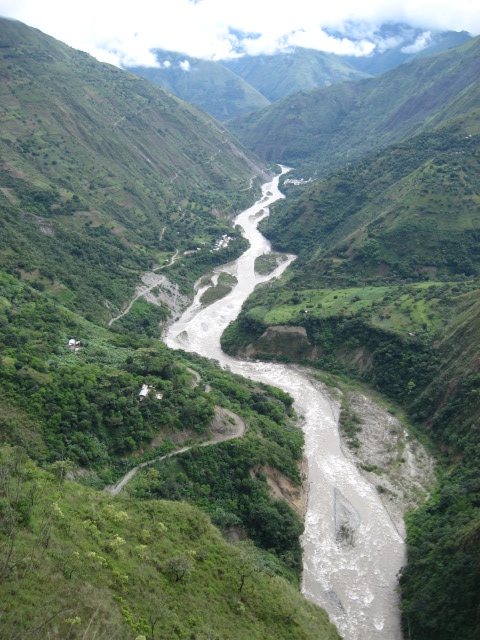
At one point we walked along an old Inca trail. They had a system quite similar to the 19th century American Pony Express. To deliver messages from Cusco, the Inca capital, to what is now Lima, runners would sprint top speed along these narrow, precipitous trails for three kilometers, where a fresh runner would take the message and sprint his three kilometers. In this way, a message could be delivered between the two cities in only one day. To put that into perspective, today it takes 20 to 24 hours for a bus to make the same journey.
The third day was much the same, but with the addition of a harrowing way to cross a river. Building bridges is evidently far to expensive and difficult, so rather the locals use a small platform suspended by pulleys on a cable which stretches across the river, essentially a zip line. Two people hop on, and it is sent down the cable, to be pulled across by a rope by a person on the other side. Yes, it was scary (the first time), but soon it became routine to be on a tiny platform a hundred feet above a raging river.
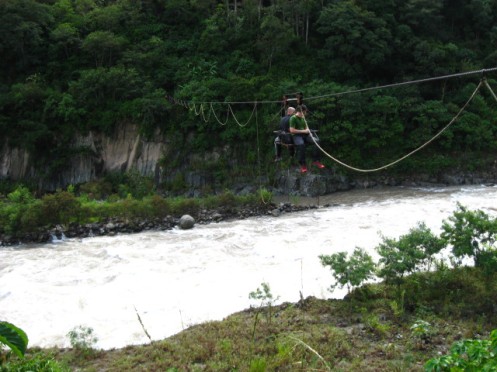
This next paragraph shall be dedicated to the weird bugs we saw along the way. Unfortunately, most moved to quickly or were too far away to properly photograph, but I got a few good ones. Everywhere there were these red and black butterflies which sat in large groups on the path, presumably (if I remember my Zoobooks correctly) extracting vital minerals from the path. These guys were so docile that they wouldn’t fly away if bothered . . . I suppose whatever they were eating had some very soothing effects. Also common were the huge butterflies which I also saw in Bolivia. About the size of my hand (I have large hands), the underside of their wings were a dull and relatively unexciting brown, though with large eyespots, but the top were this incredible iridescent blue. They were so large that the flapped through the air much like a bird, but were wary enough to avoid being photographed. I also saw for my first time ever a Monarch butterfly (or it’s extremely similar imitator butterfly). Definitely a crowning moment in my entomological observations (or is it entYmological? Sorry, dad, I always forget). We also saw a few enormous centipedes about four or five inches long. These guys were cool because as they walked their legs moved in waves up their body. It’s hard to describe . . . you really just have to see it, I guess. Then there was this monster insect with huge jaws about an inch long (the jaws, not the bug. The bug itself was the length of my finger, or a good four inches, not including the jaws). Who knows what it is or what it does, but here’s a picture of it:
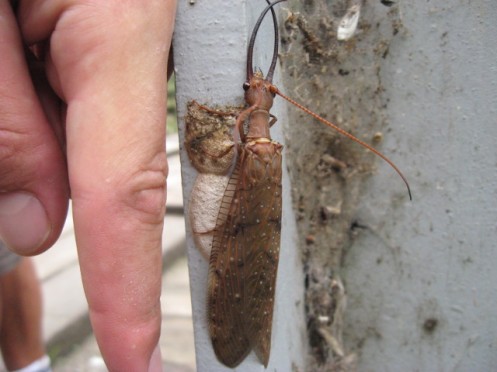
But by far the coolest were these big piles of caterpillars which squirmed along the ground all together. Each must have had at least a hundred each, and were thoroughly repulsive, yet absolutely fascinating. Dad, if you could ento(y?)mologically explain these in the comments section for the other readers of this blog, that would be really cool. Anyways, a picture is worth a thousand words . . .

Anyways, let me give you some more multimedia. Here’s a short little video clip of some of the scenery (not the best stuff; I always seem to be so awed I forget to photograph it). It’s cool.
Anyways, we trekked and trekked and trekked, and eventually we got to the horrible little town of Aguas Calientes. Here, there are more tourists and more annoying touts that Cusco, and that’s all I’ll say about it. About Cusco I will say I’m so friggin’ sick of people on the street pressuring me to buy their food, massages, drinks or drugs. (Side note: the nightlife in Cusco is weird. Walk to the main plaza, and be instantly mobbed by about a dozen touts offering free passes and free drinks to their nightclub. Brandon would always get sucked into their bullshit — they always wanted to know your name, your country, and all these personal things so you would think they were your “friends” — and apologize and apologize that he was going somewhere else for the time being. The guy just wouldn’t accept that the assholes were doing it on purpose, and actually didn’t give a damn about him except for his money and their commission. BUT, we got lots of free drinks, and went from club to club (being mobbed in between each one, of course) drinking our free cuba libres — rum and cokes — and then leaving. Getting drunk for free is easy, but really, really annoying. Oh yes, Brandon went off to Lima to meet his sister before I left on the trek, so I’m by myself again)
I’ll just skip ahead to Machu Picchu. We awoke at 4 am, and by 5 we were toiling up the eight kilometers of stairs to get to the famous site. Turns out I still have my treeplanting legs, and I easily outdistanced everybody else, but when I arrived at the top, I was greeted with a line-up of several hundred old and fat people who took the bus to the top. Honestly, there should be a special line for those who actually put in the effort to climb by themselves. This was a tourist scene I’d had yet to see: these were REAL tourists, not budget backpackers looking for culture and adventure like myself. Everybody was in a big floppy hat and silly adventurer dress, and at least 90% of the Japanese people were carrying huge tripods. Everybody was pasty pale and hurredly applying sunscreen and bug dope. Honestly, it was sickening, but it made me feel like a totally hardcore adventurer, even though I’m not, really.
Fortunately, Machu Picchu itself was amazing. What can I say? We walked all around the site, marvelling at the truly incredible stonework, set against an incredible backdrop of mountains. Just look at my pictures, you’ll understand. We also totally lucked out and had the first sunny day there in quite some time. Our guide was most impressed with our luck.
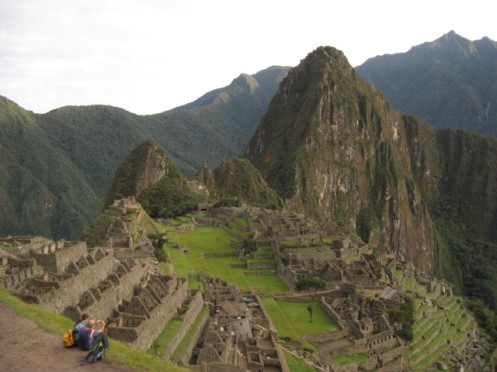
The coolest, though, was the hike up Waynu Picchu, the tooth-like mountain behind Machu Picchu you see in all the postcard pictures of the place. It was an incredible grueling climb up narrow and steep stairs, but my treeplanter legs pulled through once more and I did the 45-minutes-recommended climb in a mere 20, without rests. I earned many a raised eyebrow as I sped by hyperventilating tourists in fancy hiking boots and trekking clothes (I must say, my Blundstones absolutely rule. Buy a pair, now). Coming down was equally amusing, as I skipped down the steep stairs past “hardcore” hikers in elite name-brand gear who were clinging to the rocks in evident fear. The most hilarious were these two Japanese-Canadian girls who have evidently never left the city. Actual comment: “Like, now we can say we’ve been hiking, but oh my GOD let’s go back to the house.” Hilarious.
Here is a big picture of me just after conquoring Waynu Picchu. You can see the bus road up to Machu Picchu, but you can’t see all the stair I walked up. By the way, do you like my hat?
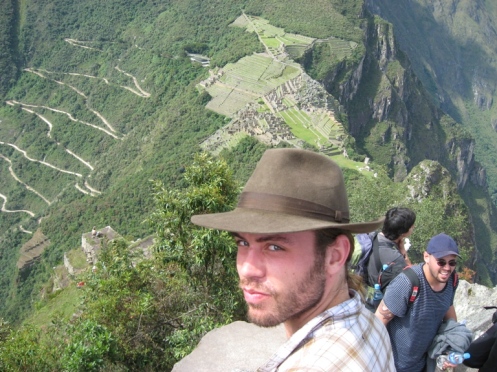
Anyways, I’m pretty tired of writing by now. I’m back here in Cusco to resusitate, do my laundry, update the blog, and get ready for the next leg of my journey. Tomorrow I leave for Lima, but when I get there I don’t even plan on leaving the bus station. I will immediately depart for Trujillo, a medium sized beach town north of Lima. After a night there I’ll take a bus to an as-yet-undecided little non-touristy village (a.k.a. not in my guidebook) on the beach, where I’ll chill out until it’s home time. I think I’ll punctuate my beach leisure time with a trek in the Cordorilla Real, which is quite close to where I’m going.
Hasta la vista, baby!
‘K Bye.

 Subscribe . . .
Subscribe . . .
turvy you are without a doubt the most awesome person i have ever met. i can not WAIT till you get back…. oh NO!!! this just crossed my mind….. when you get back, no more incredible blogging!?!?!? What will everyone DO!?!?!!? will you continue to write in here anyways after you get back? for your faithful readers who are inspierd by your work? you have such a way with words, you make everything sound facinating. ok, but seriously..
Pee-choo!?!?!?!?!?!? that is the best and most useful thing i have heard in AGES. i SHANT forget it, mi amigo.
Sorry to correct the explanation of the spelling and meaning of Machu Picchu, but since you are a Linguist, I believe it relevant.
The original Quechua spelling is interpreted by Linguists: PiX-chu, PeeK-chu, or PEEH-chu; there is no certainty as to which is correct, because the Incas had no written language. The present spelling Machu Picchu was adopted by Spanish language speakers not familiar with the Inca sounds of X, K or H. PEE-chu is the shin bone in Quechua, and Penis is Ullu. Very good Blog though.
I do admit that I didn’t take the most rigorous linguistic approach to this Quechuan tidbit, but in my defence, the information is directly from the mouth of a native Quechua speaker.
Hey Colin, it’s Dad with some belated comments on your excellent appreciation of insect aesthetics! It sounds like an entOmologist’s paradise, though– wish I was there! I can hardly wait to see the rest of the photos. Comments on the ones in this blog: The long-tusked 4-incher is a male Dobsonfly. This is a great sighting, they are usually nocturnal. The larvae are aquatic predators called Hellgrammites much loved by flyfisherfolk (I’ve named our little wooden boat the Hellgrammite, though I haven’t yet written it on the hull). The huge jaws on the male are used to hang onto the female during copulation—must be some crazy sex to need vice grips like that. Actually, they are so long that they have rather poor leverage, and can’t inflict much of a bite—something like an earwig’s pinchers, I imagine. The caterpillar cluster is a tougher one. I’m not even sure they’re caterpillars—they also look something like millipedes in your photo. If they are caterpillars, they may be related to, or at least have the same behaviour as, the Processionary Caterpillar, which makes long nose-to-tail columns of marching caterpillars on their way to their pupation site. I could not find anything on your guys online, and I’ve sent the photo around to friends-in-the-know, who turned out to be, if not foes-in-the-know, at least friends-in-the-not-know. Could be something trickles in over time. Sorry! Anyway, keep those blogs coming, I live, eat and breathe them.
P.S. Cool hat!
yes cool hat.
I can verify that they were definitely caterpillars . . . I remembered my basic entomology enough to identify the 3 real legs and the other “fake” legs. Besides, they were moving quite slowly. Perhaps I have unwittingly stumbled upon an entomological discovery of yet-to-be-plumbed significance!
I trekked through out the Andes in 1969, including Machu Picchu. I was the best time of my life.